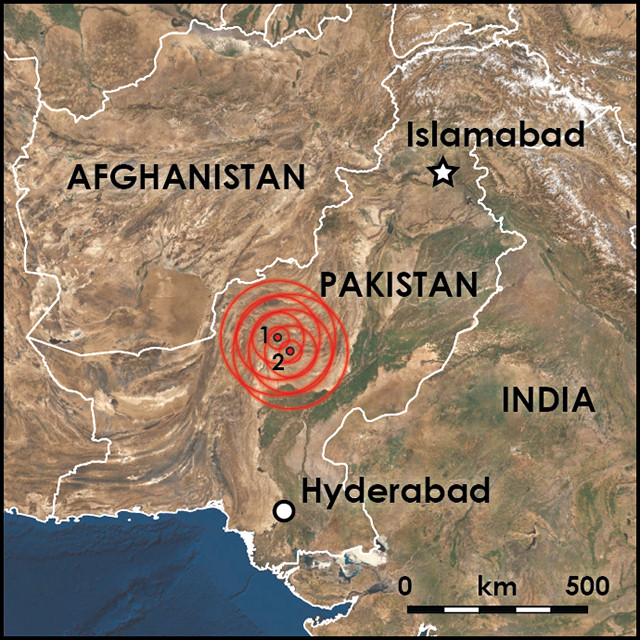
by Mary Caperton Morton Wednesday, June 29, 2016

The Harnai earthquake that shook Pakistan in 1997, initially thought to be a single magnitude-7.1 quake, was actually two quakes (red dots denote epicenters) spaced 19 seconds apart. Credit: K. Cantner, AGI.
Earthquakes are known to “jump” from one fault to another, with the ground shaking from one rupture triggering movement on nearby faults. However, evidence for earthquake transference between faults separated by more than a few kilometers has been scarce. Now, researchers looking at two closely timed earthquakes that struck Pakistan in 1997 suggest that earthquakes can jump between faults more than 50 kilometers apart, a finding that may have implications for hazard projections in Southern California and elsewhere.
On Feb. 27, 1997, the Harnai earthquake struck west-central Pakistan, killing roughly 50 people in this rural region of the Sulaiman Mountains. Initially cataloged as a magnitude-7.1 quake, a new study, using a combination of interferometric synthetic aperture radar (InSAR) and seismic data, indicates that the event was actually two earthquakes: a magnitude-7 event followed 19 seconds later by a magnitude-6.8 event on another fault 50 kilometers to the southeast.
Because the quakes occurred only seconds apart and had similar magnitudes, they are classified as a doublet quake, as opposed to a mainshock followed by an aftershock, says Edwin Nissen, a geophysicist at the Colorado School of Mines and lead author of the new study published in Nature Geoscience. The 50-kilometer distance between the faults involved is “an order of magnitude larger than what was considered possible” for an earthquake to jump, he says. “This is essentially a long jump world record.”
Most hazard projections assume that earthquakes can’t jump between faults more than 5 kilometers apart. “This statistic is ingrained in hazard studies,” says Gavin Hayes, a geophysicist at the U.S. Geological Survey National Earthquake Information Center in Denver, Colo., who was not involved in the new study.
Earthquakes jumping longer distances could have consequences for faults in many places around the world, such as Southern California, where the San Andreas Fault lies within 50 kilometers of many faults running through populated areas. “Doublets tend to increase the duration of ground shaking, as well as increase the area affected by the events,” Nissen says. “These events can produce more devastation over a larger area than a single event could.”
Doublet quakes have also been recently observed in the subduction zone off the coast of Chile, a completely different tectonic setting from Pakistan, suggesting that triggered doublets may be a more common occurrence than previously recognized, says Hayes, who wrote an accompanying commentary on the new study.
Detecting doublets is challenging as their closely spaced signals often overlap in seismograms, requiring additional analysis to tease out the individual events, Hayes says. “We need to figure out how prevalent these doublet events are; then we can make better decisions about how to incorporate them into hazard projections,” he adds.
“This event in Pakistan is 20 years old, but nobody had gotten around to looking at it in detail,” Nissen says. “I hope going forward, more people will look at past earthquakes and new events with this kind of forensic approach. Maybe we’ll see more of this doublet behavior and that will lead us to a better understanding of seismic hazards.”
© 2008-2021. All rights reserved. Any copying, redistribution or retransmission of any of the contents of this service without the expressed written permission of the American Geosciences Institute is expressly prohibited. Click here for all copyright requests.